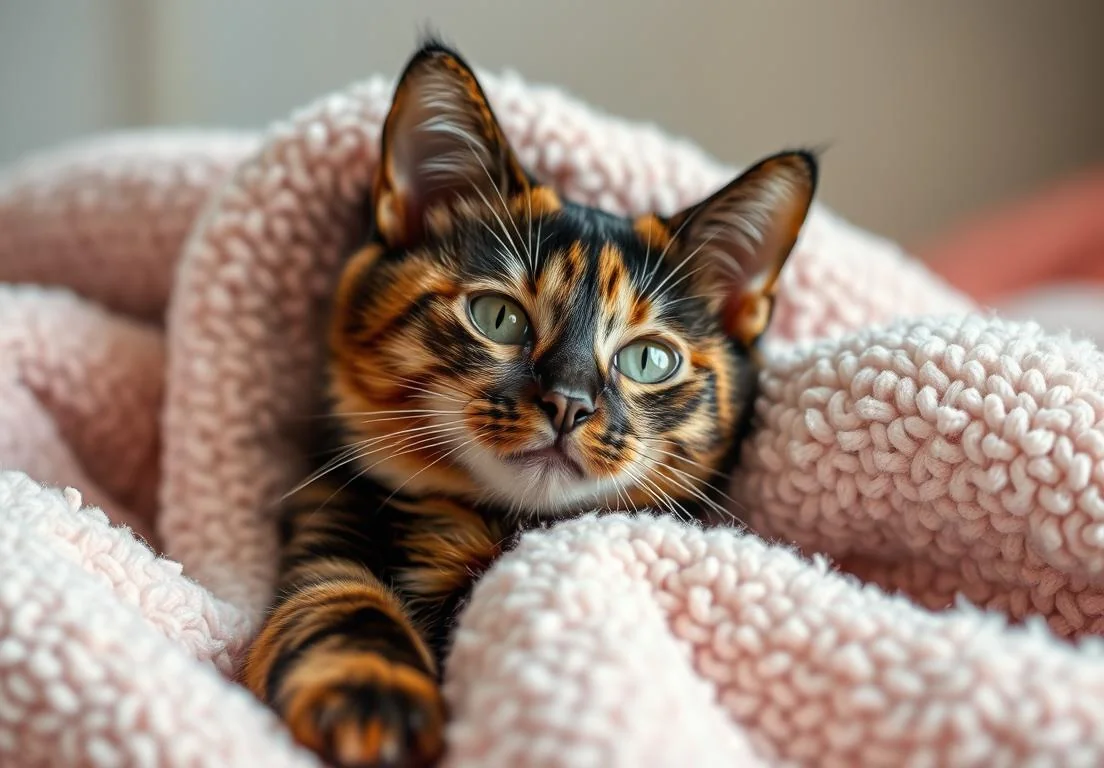Electric blankets can be cozy companions for chilly nights, but what if you have a furry friend? Cats love warmth, but are electric blankets a safe choice for our feline pals? The last thing you want is to create a risk while trying to keep them cozy.
Yes, electric blankets can be safe for cats under certain conditions. It’s vital to monitor their behavior and ensure they don’t chew or scratch at the blanket, as this could lead to serious safety hazards. But there’s more you need to know to keep your kitty safe and snug, so stick around to uncover essential tips and precautions!

What Risks Do Electric Blankets Pose to Cats?
Electric blankets might seem like a cozy addition to your home, but they come with some potential risks for curious cats. One of the primary concerns is overheating. Cats are known for their ability to find warm spots, and an electric blanket can become dangerously hot if left unattended. A cat curling up on a heated blanket could suffer from burns or heat stress, particularly if the blanket stays on for a prolonged period.
Electrical hazards also pose a significant risk. Cats, being naturally inquisitive, might chew on the blanket’s cords or the fabric itself, which can expose them to the wiring inside. This not only poses a risk of electrical shock but could also lead to a potential fire hazard if the blanket gets damaged.
Adding to this concern is the fact that most cats don’t understand the concept of heat regulation. They might lie down on a blanket without realizing it’s set to a high temperature, leading to serious health issues. Thus, while electric blankets can keep you warm, they need careful consideration when there’s a cat in the mix.
How Can You Safely Use Electric Blankets with Cats?
Using electric blankets safely around your feline friend requires a touch of mindfulness. First and foremost, always supervise your cat when an electric blanket is in use. Make it a habit to check in on them periodically, ensuring they haven’t settled into a potentially hazardous situation.
Choose blankets with auto shut-off features. Many modern electric blankets come equipped with this safety measure, which automatically turns off after a set time. This reduces the risk of overheating—an essential aspect when your cat is involved.
Another valuable tip is to monitor the temperature settings. Opt for low heat settings or even a blanket that you can adjust based on your pet’s comfort, rather than a one-size-fits-all approach.
Consider creating a designated, safe zone for your cat. Instead of allowing them to roam freely on the blanket, set up an area with soft, conventional blankets or bedding that they can use during colder months.
A unique angle to keep in mind is to train your cat to associate electric blankets with positive experiences. Gradually introduce the blanket when it’s off and reward your cat for approaching the area. This way, you’re setting the stage for a more positive—and safer—relationship with the electric blanket when it’s in use. Taking these steps can ensure your cat enjoys warmth without putting their wellbeing at risk.
What to Look for in a Cat-Safe Electric Blanket?
Choosing an electric blanket for your feline friend? Safety is your top priority. Look for low voltage options; they’re much safer for pets and reduce the risk of overheating. A timer feature is also beneficial, ensuring the blanket automatically shuts off after a set period—this prevents accidental burns or overheating if your cat gets too cozy.
Opt for blankets with a chew-resistant cord. Cats love to nibble, and a durable cord minimizes risks. Blankets made with pet-friendly materials are also a solid choice—avoid anything that could irritate your cat’s skin. Some blankets even have washable covers, which can help keep everything fresh and clean when accidents happen.
Pay attention to auto shut-off features to add an extra layer of safety. Finally, consider getting a blanket that adjusts its heat settings. That way, you can customize the warmth based on your cat’s comfort.
How to Train Your Cat to Use an Electric Blanket?
Introducing your cat to an electric blanket can be done smoothly with a little patience and creativity. Start with familiarizing your cat with the blanket while it’s turned off. Allow them to sniff and explore it; this builds curiosity without the heat component, easing any apprehension.
Next, gradually introduce the warmth. Turn the blanket on at a low temperature when your cat is nearby. Watch their reaction closely; if they seem intrigued—great! If they’re wary, don’t rush things. Use their favorite treats to encourage them to associate the blanket with positive experiences.
Always supervise their initial uses, especially if you notice any honed instincts to scratch or chew. You might even place some familiar toys or a soft bed on the blanket, making it a cozy retreat. This way, they’ll feel safe, and the blanket becomes a new favorite spot for snuggling and lounging.
Are There Alternatives to Electric Blankets for Cats?
If you’re looking for cozy ways to keep your feline friend warm without the potential hazards of electric blankets, you’ve got several safe alternatives to consider.
Heating pads designed for pets are a popular option. These pads often have safety features like auto shut-off and temperature control, providing warmth without the risk of overheating. Make sure to choose one specifically intended for animals, as they’re built to withstand a bit of the mischief cats can dish out.
Cozy cat beds with insulation can also be a great choice. These beds are often made of thicker materials or have thermal layers that retain your cat’s body heat, keeping them warm without any electricity involved. Look for beds that are machine washable for easy cleanup.
Snuggle blankets made from soft materials, like fleece, can also be effective. Cats love to burrow, and providing a warm blanket in their favorite spot can create a safe, inviting environment. You can even warm the blanket slightly in the dryer before giving it to them, just be cautious not to make it too hot.
Consider using self-warming cat pads, which contain materials that reflect body heat, keeping your pet toasty without any power source required. These can be particularly handy for older cats or those with joint issues who might appreciate a bit of extra warmth.
What Are the Signs of Overheating in Cats?
It’s vital to know the signs of overheating in cats, especially if you’re using any heated items around them. One clear indicator is increased panting. Cats typically don’t pant, so if you see this happening, it’s time to cool things down.
Another sign is restlessness. If your cat is pacing, trying to jump off their blanket, or acting unusually fidgety, they might be too warm.
Check for changes in body posture. Cats may stretch out or lie flat in an effort to release heat, which is a stark contrast to their usual curled-up positions when cozy and comfortable.
Excessive drooling or red or pale gums can also be red flags, indicating that your furry friend might be struggling with heat. In severe cases, look out for vomiting or disorientation, which are serious warning signs that require immediate attention.
Keep these signals in mind while ensuring your kitty has access to fresh water and a cool, shaded area, especially during warmer months. Keeping your cat comfortable is key to a happy, healthy life.
How Do Different Cat Breeds Respond to Heat?
Not all cats handle heat the same way, and this can influence your choice of using an electric blanket. For instance, Siamese and Burmese cats tend to be more tolerant of warmth, often seeking out cozy spots. They might enjoy the soothing heat of an electric blanket.
On the flip side, Persians and Himalayans have thicker fur, which can make them more sensitive to high temperatures. You might notice that they prefer cooler areas instead. It’s essential to consider your cat’s individual preferences.
Also, if a breed is prone to respiratory issues, like Bengals, be cautious. The added heat could exacerbate those conditions. Think about the breed’s unique traits—some might find an electric blanket a luxurious addition, while others could be uncomfortable. Pay attention to your cat’s behavior. If they seem restless or try to escape the warmth, it might be a sign to remove the blanket.
Can Electric Blankets Affect Cat Health?
Electric blankets can pose health risks to cats, especially if they have pre-existing conditions such as diabetes or heart problems. The heat can stress their systems, and for cats with sensitive skin, there might be a risk of burns or irritation.
Moreover, cats are known for their curious nature. If they chew on the blanket’s wiring, it could lead to exposure to electrical hazards. Keep an eye on your blanket’s condition — frayed wires are a big no-no!
Consider using a thermostatically controlled heating pad designed for pets as a safer option. It’s tailored to their needs and offers controlled heat levels, which can engage their natural instincts without putting them at risk.
Adding a cozy, insulated bed or blanket can also create a warm environment without the potential downsides of an electric blanket. Ultimately, be savvy about your individual cat’s health and well-being—when in doubt, consult your veterinarian for tailored advice.
What Does Recent Research Say About Cats and Heat Sources?
Recent studies highlight that cats are pretty savvy about temperature management. They naturally seek warmth but can easily overheat, especially in cozy spaces where they feel safe. A study from the Journal of Feline Medicine and Surgery noted that cats may not always recognize when they’ve gotten too hot, making supervision essential when introducing any heat source.
Electric blankets can be tempting for a snoozing kitty, but several points warrant attention. These blankets often maintain a consistent temperature, which might be comforting for us, but can be risky for kittens or older cats with compromised health. Unlike dogs that might readjust or move away when uncomfortable, cats may not show signs of overheating until it’s too late.
Interestingly, research indicates that heat sources can affect a cat’s thermal regulation. For instance, cats have a unique ability known as “thermoregulation,” allowing them to adapt to various temperatures. However, if the external heat source—like an electric blanket—overrides their natural instincts, it can lead to potential overheating or burns. It’s vital to monitor your cat’s behavior closely, especially when you use such blankets.
To ensure safety while keeping your furball warm, consider exploring alternatives. Heat pads designed specifically for pets often have adjustable settings and safety features that help prevent overheating. Providing a designated warm spot, perhaps with a non-electric blanket, can be a safe compromise. This way, your cat can enjoy the warmth without the risks associated with electric sources.
Alex, a passionate animal lover, has experience in training and understanding animal behavior. As a proud pet parent to two dogs and three cats, he founded AnimalReport.net to share insights from animal experts and expand his knowledge of the animal kingdom.




